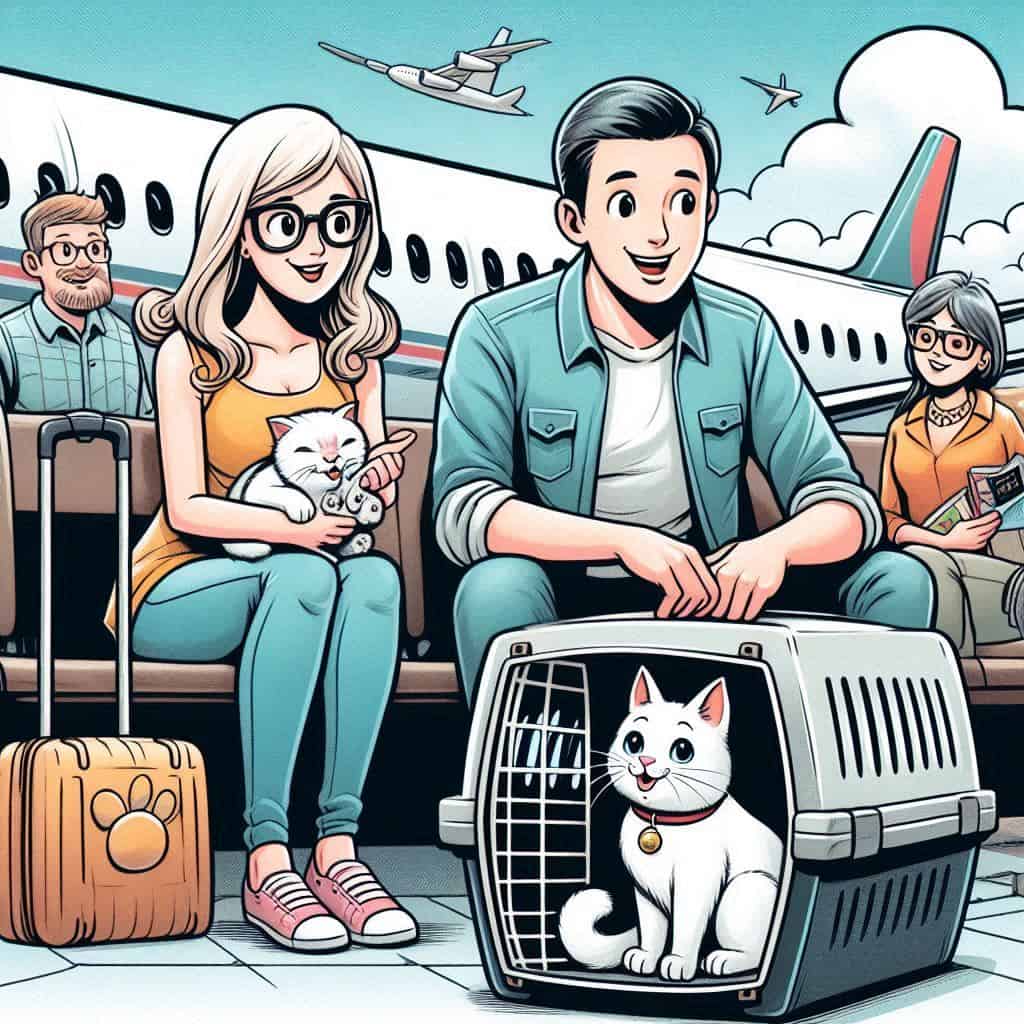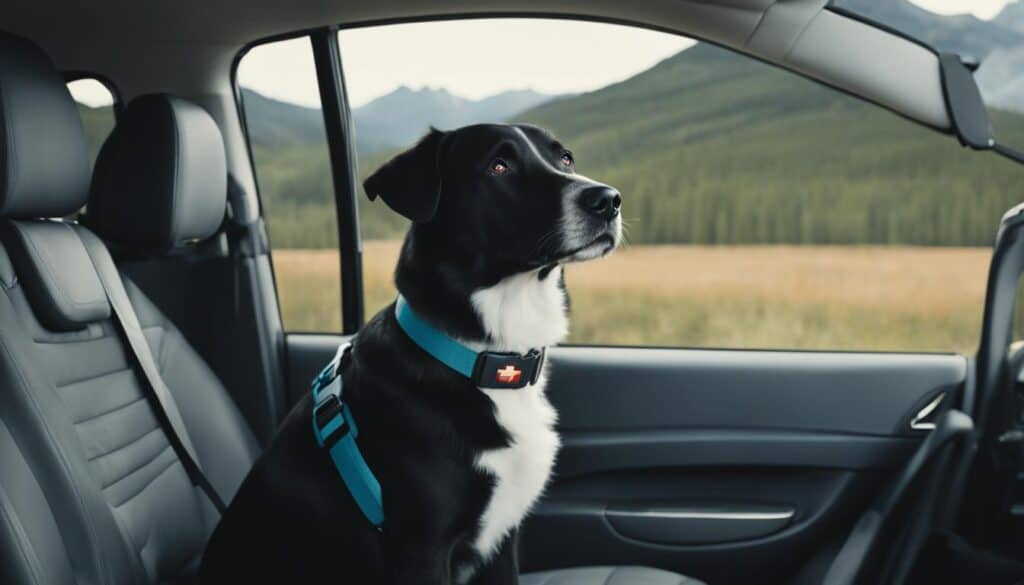
Traveling with your pet can be a joyous experience, filled with wagging tails and purring companions exploring new places alongside you. It brings a unique adventure and deepens the bond between you and your furry friend. However, the key to a successful trip lies in proper preparation.
Preparation is essential to ensure a smooth journey for you and your pet. From packing the right essentials to consulting your vet, every step contributes to their comfort and safety.
In this article, you’ll discover:
- Pet travel checklist: Must-have items for a hassle-free trip.
- Emergency kit preparation: Keeping your pet safe on the go.
- Veterinary consultations: Ensuring your pet’s health before departure.
- Car travel tips: Best practices for a safe ride.
- Air travel logistics: Navigating airline requirements.
- Crate training methods: Helping your pet feel secure.
- Feeding schedules: Minimizing travel-related nausea.
- Hydration tips: Keeping pets hydrated during journeys.
Additionally, don’t forget about the importance of securing cheap travel insurance for unforeseen circumstances during your trip. Ready to embark on an affordable adventure with your pet? Let’s dive into these essential tips to make your trip memorable and stress-free!
- 1. Pet Travel Checklist: Essentials for a Smooth Journey
- 2. Emergency Kit Preparation: Keeping Your Pet Safe on the Go
- 3. Consulting Your Veterinarian: Ensuring Your Pet's Health Before the Trip
- 4. Traveling by Car: Best Practices for Safe and Comfortable Journeys with Pets
- 5. Flying with Pets: Navigating Air Travel Requirements and Logistics
- 6. Crate Training: Helping Your Pet Feel Secure During Travel Schedules
- 7. Feeding Schedule Before Travel: Minimizing Nausea in Pets on the Move!
- 8. Keeping Pets Hydrated While Traveling: Tips from Experience!
- 9. Staying Calm During Travel: Techniques That Work!
- 10. Enjoy The Adventure Together While Prioritizing Safety And Comfort!
1. Pet Travel Checklist: Essentials for a Smooth Journey
Preparing for a road trip with your furry friend? Here’s a pet travel checklist to ensure you have everything you need for a stress-free adventure:
Essential Items
- Food and Water: Pack enough food for your trip, along with portable bowls. Don’t forget water bottles to keep your pet hydrated. If you’re traveling to places like Scotland, consider exploring their seasonal foods which can be a delightful addition to your pet’s diet.
- Leash and Harness: A sturdy leash and harness are must-haves, whether you’re exploring new trails or taking rest stops.
- Waste Bags: Always have waste bags on hand for quick and easy clean-ups.
Comfort Items
- Toys: Bring along a few of your pet’s favorite toys to keep them entertained and relaxed.
- Blankets: Familiar blankets can make any new place feel like home. They provide comfort and help manage temperature changes.
Appropriate Identification and Microchipping
Proper identification is crucial in case your pet gets lost during travel. Ensure your pet is properly identified by following these steps:
- Microchip your pet: Consider microchipping your pet, as it provides a permanent form of identification that cannot be lost or tampered with. Keep the microchip registration details up to date with your current contact information.
- Attach ID tags: Attach visible ID tags to your pet’s collar or harness, including your pet’s name, your name, and contact information. This serves as an immediate way for someone to contact you if your pet goes missing.
Ensuring appropriate identification and microchipping gives you peace of mind and significantly increases the chances of being reunited with your pet in the event they get lost during travel.
| Travel Safety Tips: | Comfort Tips: |
|---|---|
| 1. Secure your pet in a carrier or harness during transit. | 1. Bring familiar bedding and toys to provide comfort. |
| 2. Use pet-friendly travel restraints when driving. | 2. Ensure proper ventilation and temperature control in your pet’s travel crate or carrier. |
| 3. Never leave your pet unattended in a parked vehicle. | 3. Take frequent breaks to allow your pet to stretch, relieve themselves, and hydrate. |
| 4. Familiarize yourself with pet emergency procedures and nearby veterinary clinics along your travel route. | 4. Practice relaxation techniques, such as gentle petting or using calming music, to help soothe your pet. |
Having these essentials covered ensures that both you and your pet can focus on enjoying the journey ahead. For more travel tips, including some packing hacks for budget travelers, or suggestions on where to travel in January, visit Thrifty Escapades.
2. Emergency Kit Preparation: Keeping Your Pet Safe on the Go
Having an emergency kit for pets ensures peace of mind while you’re out exploring, whether it’s a serene countryside or the spooky corners of a haunted castle during one of those Scotland Haunted Tours. Here’s a handy list to get you started:
- Basic First Aid Supplies: Pack bandages, antiseptic wipes, tweezers, and a pet-safe antiseptic.
- Necessary Medications: Include any prescription meds your pet needs along with instructions for their use.
- Identification Tags: Make sure your pet’s ID tags are up-to-date with your current contact information.
- Recent Photos of Your Pet: Keep recent photos handy in case your pet gets lost; they can be invaluable for creating lost posters or sharing on social media.
Each item in this kit has a big part to play in keeping your furry friend safe. Identification tags and recent photos can make all the difference if you find yourself separated from your pet. A well-prepared kit means you’re ready for anything, allowing you to enjoy your travels without worry.
3. Consulting Your Veterinarian: Ensuring Your Pet’s Health Before the Trip
Before hitting the road or taking to the skies with your furry friend, a veterinarian consultation is a must. This step ensures your pet is in top health and ready for travel.
Why Consult Your Vet?
- Health Concerns: Discuss any existing health issues your pet may have. Your vet can provide guidance on managing these conditions while traveling.
- Medications: Get advice on any medications your pet might need during the trip. This includes regular prescriptions and potential remedies for motion sickness or anxiety.
Essential Documentation
Keeping an up-to-date health certificate and vaccination records is crucial. Some destinations require these documents for entry:
- Health Certificate: Issued by your vet, this document verifies that your pet is healthy enough to travel.
- Vaccinations: Ensure your pet’s vaccinations are current. Proof of rabies vaccination is often mandatory.
Having these essentials organized and accessible makes the journey smoother and worry-free for both you and your pet.

4. Traveling by Car: Best Practices for Safe and Comfortable Journeys with Pets
Taking a road trip with your furry friend? Here’s how to ensure a smooth ride for both of you:
Best Practices for Safe Car Travel with Pets
- Secure Your Pet Properly: Safety first! Use crates or harnesses designed specifically for pets. A secured pet is less likely to cause distractions and is protected in case of sudden stops.
- Regular Breaks: Long drives can be tough on pets. Plan regular breaks so they can stretch their legs, relieve themselves, and rehydrate.
Hot Car Dangers: Protecting Your Pet from Heatstroke During Road Trips
It’s crucial to understand the risks associated with leaving pets unattended in a parked car during warm weather. Even a few minutes can be dangerous.
- Never Leave Pets Unattended: On a hot day, the temperature inside a parked car can soar quickly, posing serious risks to your pet’s well-being.
- Recognize Signs of Heatstroke: Watch out for symptoms like excessive panting, drooling, lethargy, or vomiting. If you suspect heatstroke, act fast—move your pet to a cool area and offer water. Seek veterinary care immediately.
Traveling by car with your pet can be an enjoyable experience if you follow these tips. From ensuring their safety with proper restraints to recognizing the early signs of heatstroke, these practices are essential for a stress-free journey.
However, if you’re considering extending your travels beyond the open road, shopping in Taipei could be a delightful experience with its popular shopping districts and malls. Alternatively, if you’re looking for affordable accommodation while exploring bustling cities like Bangkok, check out this guide on the cheapest hotels in Bangkok.
5. Flying with Pets: Navigating Air Travel Requirements and Logistics
Airline Policies
Flying with a pet can be an exciting yet daunting experience. Airlines have different policies regarding pet travel, and it’s important to understand these before booking your flight. Some airlines allow pets in the cabin, but there are often size and weight restrictions.
Check if your pet meets the requirements for in-cabin travel. If not, they may need to travel in the cargo hold. Research each airline’s specific rules:
- In-Cabin Pets: Usually limited to small dogs and cats that fit under the seat.
- Cargo Hold: Suitable for larger pets, but ensure the airline has a good reputation for handling pets safely.
Preparing Your Pet for Air Travel
Getting your furry friend ready for air travel involves more than just booking a ticket. Acclimating them to their carrier is key:
- Introduce the carrier weeks in advance: Let them explore it at home so they feel comfortable.
- Practice short trips: Take them on car rides in their carrier to simulate travel conditions.
- Comfort items: Include a familiar blanket or toy in the carrier.
Health Certificates and Vaccination Records
Before flying, you’ll need essential documentation. Health certificates issued by a veterinarian confirm that your pet is fit for travel and free from contagious diseases.
Key Documents:
- Health Certificate: Often required within 10 days of departure.
- Vaccination Records: Proof of up-to-date vaccinations, particularly rabies shots.
Keeping these records organized is vital. A dedicated folder or digital copies on your phone can make access easy during check-ins or emergencies.
Navigating air travel with pets requires preparation but ensures a smooth journey for both you and your furry companion.
Budget Travel Tips
If you’re considering traveling on a budget while flying with pets, explore savvy strategies for affordable travel with my ultimate guide on how to travel on a budget, from cheap flights to frugal accommodations.
Ready to take off? Let’s dive into more tips on keeping your pet secure during transit!
6. Crate Training: Helping Your Pet Feel Secure During Travel Schedules
Crate training for pets can transform travel into a stress-free experience. Getting your pet comfortable with their crate before the journey begins is key.
Steps to Acclimate Your Pet:
- Introduce the Crate Slowly: Place the crate in a common area of your home. Let your pet explore it at their own pace.
- Make It Comfortable: Add soft bedding and a favorite toy inside the crate to make it inviting.
- Positive Reinforcement: Give treats and praise when your pet enters the crate willingly.
- Gradual Increase of Containment Time: Start with short periods of time in the crate and gradually increase as your pet becomes more comfortable.
Benefits of Crate Training:
- Safety First: A well-trained pet in a secure crate minimizes distractions for the driver and reduces injury risk during sudden stops.
- Stress Reduction: Familiarity with the crate helps pets feel safe, reducing anxiety during transit.
- Comfort During Travel: The crate serves as a personal sanctuary, providing a sense of security amidst unfamiliar surroundings.
Crate training not only makes travel safer but also ensures your furry friend feels at ease throughout the journey.
7. Feeding Schedule Before Travel: Minimizing Nausea in Pets on the Move!
Keeping your pet’s tummy happy is key to a smooth travel experience. Timing is everything when it comes to feeding your pet before departure. Aim to feed them around 2-3 hours before you hit the road or head to the airport. This window helps prevent motion sickness, giving their stomach enough time to settle.
When it comes to what to feed them, stick with their usual diet. Sudden changes can upset their stomach and lead to discomfort during travel. Some safe food picks include:
- Regular kibble or wet food: Keep it consistent with what they eat daily.
- Light snacks: If they need a little something closer to departure, opt for easily digestible options like plain cooked chicken or rice.
Avoid overfeeding or introducing new treats right before travel. Their digestive system will thank you!
If you’re considering a trip that involves staying at unique accommodations, like a capsule hotel in Taipei, remember that these hotels offer a compact yet comfortable stay, perfect for short visits. However, if luxury is what you’re after, there are plenty of best hotels in Taipei that provide exceptional hospitality and comfort.
8. Keeping Pets Hydrated While Traveling: Tips from Experience!
When it comes to keeping pets hydrated while traveling, it’s crucial to maintain their hydration levels, particularly during hot weather or long journeys with limited access to water.
Creative solutions for hydration on the go include:
- Spill-proof containers: These are perfect for travel as they minimize mess and waste.
- Freezing water bottles: This helps keep the water cool longer, providing a refreshing drink for your pet when needed.
However, ensuring your pet stays hydrated is just one aspect of a successful journey. If you’re planning a trip that involves taking taxis in places like Yilan, Taiwan, you might want to consider how the travel method affects your pet’s comfort and access to water.
Moreover, if air travel is part of your itinerary, saving money at the airport can also alleviate some stress and allow you more time to focus on your pet’s needs.
Remember, staying vigilant about your pet’s hydration can make the journey smoother and more enjoyable for both of you!
9. Staying Calm During Travel: Techniques That Work!
Traveling with your pet can be a whirlwind of emotions, but staying calm is crucial. Pets often mirror our anxiety, so maintaining a relaxed demeanor can make all the difference.
Calming Techniques for Pets
- Deep Breathing Exercises: Yes, these aren’t just for us! Practicing deep breaths can help both you and your pet stay calm. When you feel the tension rise, take a moment to breathe deeply and exhale slowly.
- Favorite Toys or Blankets: Bringing along familiar items can provide comfort and reduce anxiety. A favorite toy or blanket can work wonders in creating a sense of normalcy.
- Soft Music or White Noise: Some pets respond positively to calming sounds. Playing soft music or white noise can soothe your pet during travel.
Influence of Owner’s Demeanor
Your calmness sets the tone for the trip. When you’re relaxed, your pet is more likely to follow suit:
- Positive Reinforcement: Use a soothing voice and gentle pats to reassure your pet.
- Stay Present: Focus on the journey rather than potential stressors. Your mindfulness can help keep anxiety at bay.
By employing these techniques, you create a tranquil environment that enhances the travel experience for both you and your pet.
Now, imagine combining these calming techniques with an exciting adventure in a beautiful destination like Yilan, Taiwan. With its coastal paradise and numerous attractions, Yilan could be the perfect getaway for you and your furry friend. Let’s embark on this adventure together with calm hearts and wagging tails!
10. Enjoy The Adventure Together While Prioritizing Safety And Comfort!
Traveling with your pet is a joyous experience, filled with shared adventures and memories. Preparation is key to ensuring a smooth journey.
Summary of Pet Travel Tips:
- Pack Essentials: Include food, water, leash, waste bags, toys, and blankets.
- Emergency Kit: Basic first aid supplies, medications, up-to-date identification tags.
- Vet Consultation: Discuss health concerns and get necessary documents.
- Car Travel: Secure pets with crates or harnesses, take breaks.
- Air Travel: Understand airline policies and prepare necessary paperwork.
Prioritize safety and comfort to make every trip enjoyable for both you and your furry friend!

Summing UP
Traveling with your pet can be an incredibly rewarding experience, providing opportunities to explore new places and create lasting memories together.
With thorough preparation, including packing essential items, consulting your veterinarian, and understanding travel logistics, you can ensure a safe and enjoyable journey for both you and your furry companion. Whether by car or plane, prioritizing safety and comfort will allow you to fully enjoy the adventure.
So pack your bags, follow the tips outlined in this guide, and embark on a memorable trip with your beloved pet!
FAQs
How can I find pet-friendly accommodations?
Here are some tips to help you locate pet-friendly places:
1. Online Travel Platforms
- Search Filters: Use websites like Airbnb, Booking.com, or Expedia. Utilize the search filters to select “pet-friendly” options.
- Reviews: Read reviews from other pet owners to gauge the quality of the accommodations and their pet policies.
2. Dedicated Pet Travel Websites
- Specialized Sites: Websites like BringFido or PetsWelcome focus specifically on pet-friendly lodging and can provide a wealth of options.
- User-Generated Content: These sites often feature user reviews and tips on the best places to stay with pets.
3. Contacting Hotels Directly
- Call Ahead: Sometimes, hotels may allow pets even if they don’t advertise it. A quick call can clarify their pet policy.
- Ask About Fees: Inquire about any extra fees or deposits required for bringing your pet.
4. Local Resources
- Tourism Boards: Check with local tourism boards or visitor centers for recommendations on pet-friendly accommodations.
- Veterinary Clinics: Local vets often have insights into pet-friendly places in the area.
5. Social Media and Forums
- Pet Owner Groups: Join pet-related groups on social media platforms where members can share their experiences and recommendations.
- Travel Blogs: Many travel bloggers focus on pet-friendly travel and may have lists or guides to help you find suitable places.
6. Mobile Apps
- Travel Apps: Download apps like PetFriendly or Rover, which can help you find pet-friendly accommodations on the go.
- Maps Feature: Use map applications to find nearby pet-friendly hotels or rentals while traveling.
What types of fees or deposits are typically required for traveling with pets?
When planning to travel with your pet, you will want to be aware of the various fees and deposits that may be required. Here’s a breakdown of common costs you might encounter:
1. Airline Fees
- Pet Carrier Fee: Many airlines charge a fee for bringing your pet in a carrier, which can range from $75 to $500 depending on the airline and destination.
- Pet in Cabin Fee: If your pet is traveling with you in the cabin, there may be an additional fee, often around $100 to $200.
2. Hotel Deposits
- Pet Deposit: Many hotels require a refundable pet deposit, which can range from $50 to $200. This is to cover any potential damages caused by your pet.
- Daily Pet Fee: Some hotels charge a daily fee for pets, typically between $10 to $50 per night.
3. Pet Insurance
- Travel Insurance: Consider purchasing travel insurance that covers your pet. Costs can vary widely, but it’s typically around $30 to $100 for a trip.
4. Transportation Costs
- Pet Taxi or Shuttle Services: If you need to transport your pet to the airport or another location, there may be additional fees for pet-friendly transportation services, often ranging from $20 to $100.
5. Health Certificates
- Veterinary Fees: If you’re traveling internationally or to certain states, you may need a health certificate from a veterinarian, which can cost between $50 to $150.
6. Miscellaneous Fees
- Pet Supplies: Don’t forget to budget for pet supplies like food, water bowls, and leashes, which can add up to $20 to $100 depending on your pet’s needs.
- Emergency Fund: It’s wise to set aside some extra funds for unexpected expenses related to your pet, such as veterinary care.
Helpful Reads 📖
- https://www.sickgirltravels.com/home/everything-you-need-for-a-road-trip-with-dogs-dog-travel-essentials
- https://be.chewy.com/how-to-travel-with-your-dog-a-complete-guide-to-hitting-the-road-with-your-pup-2/
- https://www.akc.org/expert-advice/travel/complete-guide-to-traveling-with-your-dog/

Anne Thomas is a resourceful freelance writer with a passion for history and a knack for uncovering hidden gems on her global journeys. She roams the globe in search of untold stories and historical treasures without breaking the bank.
When she’s not deciphering ancient scripts or exploring archaeological sites, you can find her in a cozy library with a cup of tea, diving into old books and manuscripts from different eras.

